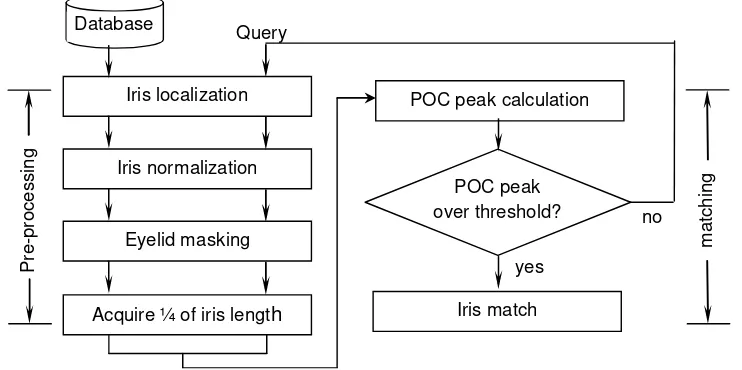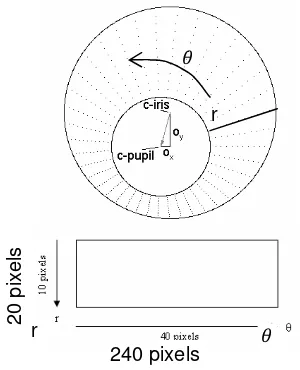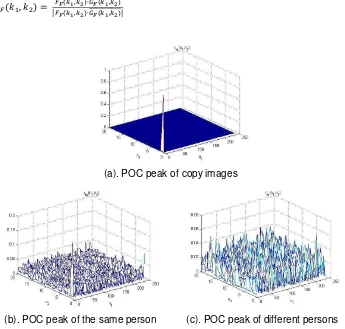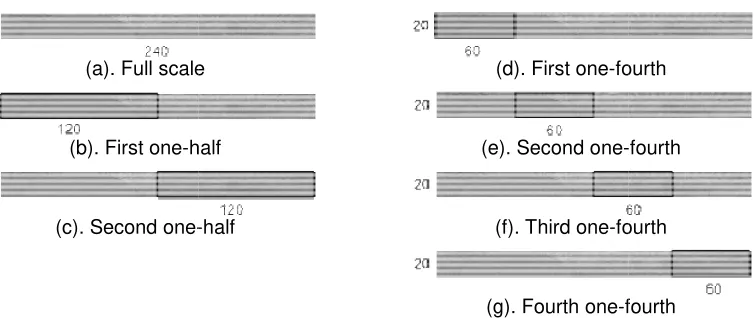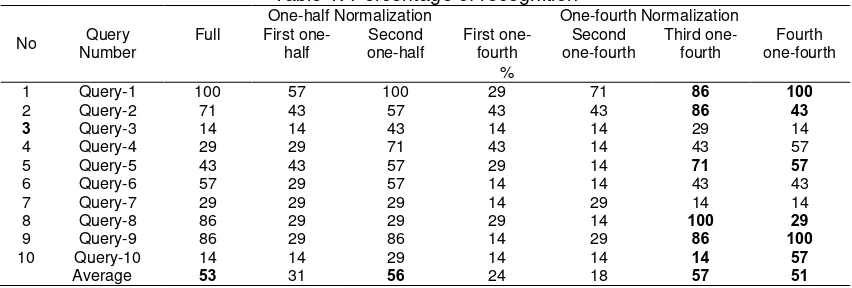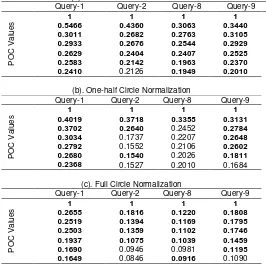ISSN: 1693-6930
accredited by DGHE (DIKTI), Decree No: 51/Dikti/Kep/2010 387
Enhancement of Iris Recognition System Based on
Phase Only Correlation
Fitri Arnia*, Nuriza Pramita
Dept. of Electrical Engineering, Faculty of Engineering, Syiah Kuala University Jl. T. Syech Abdurrauf No. 7 Darusslam, Banda Aceh, 0651-7554336
e-mail: [email protected]
Abstrak
Pengenalan iris mata adalah salah satu sistem pengenalan/identifikasi berbasis biometrik. Banyak teknik yang digunakan untuk menghasilkan tingkat pengenalan yang tinggi, salah satunya adalah metode korelasi berbasis fasa (KBF). Puncak korelasi yang tinggi dan signifikan mengandung arti bahwa sistem mengenali iris mata dari subjek (orang) yang sama, sedangkan puncak korelasi yang rendah dan tidak signifikan berarti sebaliknya. Metode KBF yang ada sekarang belum meneliti ukuran iris minimum yang bisa digunakan untuk tetap menghasilkan puncak korelasi yang tinggi. Paper ini mengusulkan penggunaan hanya seperempat dari ukuran iris penuh untuk mencapai tingkat pengenalan yang sama atau lebih baik dari penggunaan iris ukuran penuh (IUP) atau setengah ukuran penuh (SUP). Simulasi pada database citra iris CASIA-1, menunjukkan bahwa tingkat pengenalan rata-rata dari metode usulan mencapai nilai 67%, lebih tinggi daripada menggunakan SUP, dengan nilai rata-rata pengenalan 56%, atau IUP dengan nilai 53%. Selanjutnya, 100% nilai korelasi dari metode usulan lebih tinggi daripada nilai korelasi menggunakan IUP.
Kata kunci: biometrik, Korelasi Berbasis Fasa (KBF), pengenalan iris, pencocokan citra, database citra
Abstract
Iris recognition system is one of biometric based recognition/identification systems. Numerous techniques have been implemented to achieve a good recognition rate, including the ones based on Phase Only Correlation (POC). Significant and higher correlation peaks suggest that the system recognizes iris images of the same subject (person), while lower and unsignificant peaks correspond to recognition of those of difference subjects. Current POC methods have not investigated minimum iris point that can be used to achieve higher correlation peaks. This paper proposed a method that used only one-fourth of full normalized iris size to achieve higher (or at least the same) recognition rate. Simulation on CASIA version 1.0 iris image database showed that averaged recognition rate of the proposed method achieved 67%, higher than that of using one-half (56%) and full (53%) iris point. Furthermore, all (100%) POC peak values of the proposed method was higher than that of the method with full iris points.
Keywords: biometrics, Phase Only Correlation (POC), iris recognition, image matching, image database
1. Introduction
Biometric identification, which uses physiological characteristics of a person, has become an important research field in the last decades. It has been also prevalence due to its high reliability for personal identification. Several characteristics used for identification are fingerprints, footprints, palmprints, palm vein patterns, retinas, irises, facial characteristics, signatures, and vocal qualities [1] - [7]. Among those characteristics, iris is one that facilitates highly security system, in which misidentification rate is 1/1200000 (i.e.: among 1200000 identifications, one identification is false) [8]. Iris identification systems have been applied in access control, national ID card, border crossing, welfare distributions and missing children identification[9].
TELKOMNIKA Vol. 9, No. 2, August 2011 : 387 – 394
frequencies and size parameters for 2D Gabor filter kernel [11]. To solve these problems, several authors proposed to compare transformed iris images in Fourier domain [11], [12], [13]. Specifically, the autors matched only the phase components in 2D DFTs (two-dimensional Discrete Fourier Transforms). The approach is known as phase only correlation (POC).
An extensive research of using POC for iris recognition has been conducted in [11]. Moreover, the authors expanded their research using band-limited phase only correlation (BLPOC), which was able to achieve higher correlation peak. Author in [12] developed a POC-based iris recognition system by proposing an elliptic limited phase-only correlation (EPOC) method. It was reported that the proposed method had better performances than BLPOC for the database used in the experiment. Anand et. al. proposed an iris recognition system based on hierarchical phase-based matching, in which matching processes are accomplished in sub-regions of iris images [13]. A recognition system based on POC should identifies/recognizes subjects/images of the same classes with higher correlation values, which is indicated by a present of a peak (POC peak). Conversely, it should recognize them of different classes with lower correlation values, without any POC peak.
In this paper, we propose an enhancement of an iris recognition system based on POC, by increasing POC peak values. Fortunately, we can achieve higher correlation by reducing iris points included in matching stage. Our contribution is twofold; increasing the POC peak and at the same time reducing iris points incorporated in matching stage. The former can increase matching score and the latter can reduce storage requirement. The method was evaluated using CASIA (Chinese Academy of Science – Institute of Automation) iris image database [14]. Simulation showed that averaged recognition rate of the proposed method achieved 67%, higher than that of using one-half (56%) and full (53%) iris point. Furthermore, all (100%) POC peak values of the proposed method was higher than that of the method with full iris points. The rest of the paper is organized as follows. Section 2 reviews fundamental processes in POC-based iris matching and highlights our approach to improve the work. Results and discussion are given in Section 3. Finally, section 4 provides a conclusion and future direction of the work.
2. Research Method
Figure 1 illustrates the processes accomplished in this research, which can be classified into two stages namely: pre-processing and matching. In pre-processing stage, firstly, iris of querying person is (1) localized and (2) normalized. Then (3) eyelid masking is accomplished on normalized iris. These steps are followed by (4) acquiring one-fourth of iris length. Previous methods either use all iris length [17] or one-half of iris length [11]. The images from the database also experience this pre-processing stage. In the matching stage, both images from the querying person and the database are compared by POC approach, and the POC peak is then calculated.
yes Query
Database
Iris localization
Iris normalization
Eyelid masking
Acquire ¼ of iris length
POC peak calculation
Iris match
no POC peak
over threshold?
P
re-p
roc
es
s
ing
m
at
c
hi
ng
If the POC peak is higher than a defined threshold, the querying person is recognized. Otherwise, the querying processes are started all over again.
2.1. Pre-processing Stage
Figure 2 (a) shows a front-view of the human eye which includes: eyelid, eyelashes, pupil, iris, sclera, collarette and specular reflection. The average diameter of the iris is 12 mm, and the pupil size can vary from 10% to 80% of the iris diameter. Iris is a circular region between pupil and sclera and can be localized using the circular Hough transform. In Figure 2 (a), the circular Hough transform is used to detect circular boundary between sclera and iris (showed by the bigger circle) and a boundary between iris and pupil (showed by the smaller circle). A technique is also required to exclude eyelids, eyelashes and specular reflections [10], [15], [16], [17].
Normalisation of iris regions was implemented based on Daugman’s rubber sheet model. Figure 2 (b) illustrates the normalisation process.The centre of the pupil was considered as the reference point, and radial vectors pass through the iris region. A number of data points are selected along each radial line and this is defined as the radial resolution. The number of radial lines going around the iris region is defined as the angular resolution. For a non- concentric pupil, a remapping formula is needed to rescale points depending on the angle around the circle [17].
(a). A front-view of the human eye
(b). Iris normalization
Figure 2. Iris localization and iris normalization
2.2. Phase Only Correlation
The fundamental process in the matching stage is correlation of image phase, which is known as Phase Only Correlation (POC). In this section we briefly illustrate of how to use POC in recognition context and then we describe mathematical formula of the POC.
Figure 3 illustrates an interpretation of using the POC in recognition context. There are three possible conditions that are possibly observed, namely: (a) if POC peak value of two images is “1”, the first images is a copy of the second one, indicating that the images are from the same person, (b) if POC value of two images is lower than “1”, but the POC peak can be observed, the two images may be considered as originated from the same person, (c) if POC peak of two images is does not appear, the two images can be considered as originated from different persons.
Consider two images ଵ,ଶ and ଵ,ଶ with size of ଵ× ଶ. Index of the image ranges between 0 ≤ଵ≤ଵ, and 0 ≤ଶ≤ଶ. The 2D Discrete Fourier Transform (2D-DFT) of the images are denoted by ிଵ,ଶ and ிଵ,ଶ respectively, in which 0 ≤ଵ≤ଵ and
r
240 pixels
2
0
p
ix
e
ls
r
eyelashes
TELKOMNIKA Vol. 9, No. 2, August 2011 : 387 – 394
0 ≤ଶ≤ଶ. The cross-phase spectrum (or normalized spectrum) ிଵ,ଶ of those two images are given by:
ிଵ,ଶ= หிிಷሺభ,మሻ∙ீതതതതതതതതതതതതതതಷሺభ,మሻ
ಷሺభ,మሻ∙തതതതതതതതതതതതതതหீಷሺభ,మሻ (1)
(a). POC peak of copy images
(b). POC peak of the same person (c). POC peak of different persons
Figure 3. Interpretation of using POC in recognition context
Here, ଵ,ଶ denotes the complex conjugate of ଵ,ଶ.
The POC function ிଵ,ଶ is the 2D IDFT of ிଵ,ଶ and is given by:
ிଵ,ଶ= ேଵ
భ∙ேమ
∑ ∑ ிଵ,ଶே
భ
ିభభ
ேమ
ିమమ మ
భ (2)
with
ே=−2/ (3)
3. Results and Analysis
Result and analysis will be focused on one-fourth circle normalization, half-circle and full circle normalization. The latter were accomplished for comparison purposes. The next sub-sections present simulation conditionss, which consist of: simulation preparation, simulation procedure and evaluation method.
3.1. Simulation Conditions Simulation Preparation
The iris images were from the CASIA’s database version 1.0 that contains 756 images of 108 Asian eyes (each person has 7 images, photographed at different times), each of 320 x 280 pixels. All images were then normalized according to [3] to 20 x 240 pixels.
db-2,..., db-756. Furthermore: only one-fourth of full iris size pixels) and one-half of full no light-grey, and dark-grey. Lin proposed scheme was able schemes. For example, at line while scheme second one-ha
Furthermore, lines hig method achieved lower recog four, the proposed method ca second one-half, recognition r
re: query-1-a correspons to the first query, photog uery-1-c are called the versions of query-1. In word en query-1-a, query-1-b and query-1-c are the ph at three different times.
full, one-half and one-fourth of iris size that will be half circle normalization and one-fourth circ an iris normalized at full scale (20 x 240 pixels).
d by black box) that was used for comparison. We ize (20 x 60 pixels). For evaluation, images of full nomalized iris size (20 x 120 pixels) were also use querying with the area depicted in Figure 4 (c)
hile simulation of querying with the area depicted h one-fourth. These terminologies are valid for other
version 1.0 has 756 iris images from 108 perso ersions in the database (totally seven irides), whic query-1-g. If all versions of an iris are recognized, r POC peak value of all six other versions should re, POC peak of the proposed method should be h
ale (d). First one-fo
half (e). Second
one--half (f). Third one-fo
(g). Fourth one-fo
Area of irides used for comparison in simulation
s of all querying schemes. Average of recognition le normalization (presented by data of second on presented by data of third one-fourth and fourth one
% and 51% respectively. To be fair, we will focus
e highlighted Table 1 in three grey-scale gradation Lines highlighted by light-grey are querying resu le to achieve the same or higher recognition rate line nine, the proposed scheme can achieve a 100% half resulted in 86% and full normalization resulted highlighted by dark-grey are querying results in wh
TELKOMNIKA Vol. 9, No. 2, August 2011 : 387 – 394
All querying results in line number three (highlighted in white) were less than 50%. It means that none of the scheme can achieve a reasonable recognition. Therefore, we inspected the iris image, and it turned out that the normalized iris image is mostly covered by eyelid. Extracted region becomes too small to perform image matching.
Averaging the data from scheme third one-fourth and scheme fourth one-fourth (a higher value between these two approach is selected as representative), resulted in 67% recognition rate. While averaged recognition rate of using one-half circle normalization was 56% and full circle normalization was 53%.
3.3. One-fourth Circle Normalization
Tables 2 (a) – (d) provide the POC peak values of 4 query images when correlated with the images in the database. The correlation values had been sorted from the highest to the lowest ones. There were 756 images in the database, yet for convenience, only POC results of 10 images are shown. POC values of a query’s versions were printed in bold. Title of sub-tables are denoted similar to the scheme to partition iris images described in Section 3.1. The data shown in the Table 2 was the best one between scheme third fourth and fourth fourth from Table 1. For example, for query-1, the data shown were from scheme fourth one-fourth (Figure 4 (g)), while for query-8, the data shown was from scheme third one-one-fourth (Figure 4 (f)). In this and subsequent sections, the term one-fourth circle normalization refers to the best results between fourth one-fourth and third one-fourth.
In Table 2 (a), (c) and (d), all POC values of query’s versions were positioned at the highest ranks (rank 1 to rank 7). While in Table 2 (b) POC values of five versions of query-2 were positioned at the highest ranks. Regardless that the data presented here are the best results from the simulation, it implies that based on one-fourth circle normalization, POC can be used to recognize irides of a person.
3.4. Comparison of One-fourth, One-half and Full Circle Normalization
Table 3 shows the POC results of one-fourth, one-half and full circle normalization. POC values of a query’s versions were printed in bold. If the first seven entries are bold, it indicates that that the system can recognize the iris with 100% recognition rate. It is worth to note that for scheme one-half circle normalization the data was derived from the column ‘second one-half’ in Table 1.
Table 1. Percentage of recognition
No Number Query Full
One-half Normalization One-fourth Normalization
First one-half
Second one-half
First one-fourth
Second one-fourth
Third one-fourth
Fourth one-fourth %
1 Query-1 100 57 100 29 71 86 100
2 Query-2 71 43 57 43 43 86 43
3 Query-3 14 14 43 14 14 29 14
4 Query-4 29 29 71 43 14 43 57
5 Query-5 43 43 57 29 14 71 57
6 Query-6 57 29 57 14 14 43 43
7 Query-7 29 29 29 14 29 14 14
8 Query-8 86 29 29 29 14 100 29
9 Query-9 86 29 86 14 29 86 100
10 Query-10 14 14 29 14 14 14 57
Average 53 31 56 24 18 57 51
Table 2. The POC Peak Values of Several Query Images of One-fourth of Normalized Irides
(a). Query-1; Scheme:fourth one-fourth (b). Query-2; Scheme: third one-fourth
Rank Database Image POC Values Rank Database Image POC Values
1 query-1 1 1 Query-2 1
(c). Query-8; Scheme: third one-fourth (d). Query-9; Scheme: fourth one-fourth
Rank Database Image POC Values Rank Database Image POC Values
1 query-8 1 1
Table 3. Comparison of One-fourth, One-half and Full Circle Normalization (a). One-fourth Circle Normalization
Query-1 Query-2 Query-8 Query-9
P
Query-1 Query-2 Query-8 Query-9
P
Query-1 Query-2 Query-8 Query-9
TELKOMNIKA Vol. 9, No. 2, August 2011 : 387 – 394
by a-half, we suggest to interchange those two areas (namely third fourth and fourth one-fourth) in implementation, to achieve a higher POC peak values.
4. Conclusion
We proposed an enhancement of an iris recognition system based on phase only correlation (POC). Enhancement is achieved by increasing the POC peak of iris images of the same persons. Our contribution is twofold; increasing the POC peak and at the same time reducing iris points incorporated in matching stage to one-fourth of original size. The former can increase matching score and the latter can reduce storage requirement. Simulation on CASIA iris image database showed that averaged recognition rate of the proposed method achieved 67%, higher than that of using one-half (56%) and full (53%) iris point. Furthermore, all (100%) POC peak values of the proposed method were higher than those of the method with full iris points.
References
[1] Putra IKGD, Erdiawan. High Performance Palmprint Identification System Based On Two Dimensional Gabor. TELKOMNIKA: Indonesian Journal of Electrical Engineering. 2010; 8(3): 309-318.
[2] Lata YV, Tungathurthi CKB, Rao HRM, Govardhan A, Reddy LP. Facial Recognition using Eigenfaces by PCA. International Journal of Recent Trends in Engineering. 2009; 1(1): 587-590. [3] Jia W, Hu RX, Gui J, Lei YK. Newborn Footprint Recognition Using Band-Limited Phase-Only
Correlation. In. D. Zhang and M. Sonka. LNCS 6155. Berlin Heidelberg: Springer Verlag; 2010: 83-93.
[4] Ma L, Wang Y, Tan T. Iris Recognition Using Circular Symmetric Filters. International Conference on Pattern Recognition. Istanbul. 2002; 2: 414-417.
[5] Ito K, Aoki T, Nakajima H, Kobayashi K, Higuchi T. A Palmprint Recognition Algorithm Using Phase-Based Image Matching. ICIP. Atlanta. 2006; 2669-2672.
[6] Fierrez-Aguilar J, Nanni L, Lopez-Pe˜nalba J, Ortega-Garcia J, Maltoni D. An On-Line Signature Verification System Based on Fusion of Local and Global Information. In T. Kanade, A. Jain, N.K. Ratha. LNCS 3546, Berlin Heidelberg: Springer Verlag; 2005: 83-93.
[7] Ma L, Tan T, Wang Y, Zhang D. Efficient Iris Recognition by Characterizing Key Local Variations. IEEE Transaction on Image Processing, 2004: 13(6). 739-750.
[8] AIM Japan, Automatic Identification Seminar, Sept 14th, 2001.
[9] Sun Z, Tan T. Ordinal Measure for Iris Recognition. IEEE Transactions on Pattern Analysis and Machine Intelligence. 2009; 31(12): 2211-2226.
[10] Daugman J. How iris recognition works. IEEE Conference on Image Processing. Rochester, New York. 2002; 1: 33-36.
[11] Miyazawa K, Ito K, Aoki T, Kobayashi K, Nakajima H. A Phase-Based Iris Recognition System. In: D. Zhang, A.K. Jain, Editors. Lecture Notes in Computer Science (LNCS) 3832. Berlin Heidelberg: Springer Verlag; 2005: pp. 356-365.
[12] Teusdea IC. Phase-Only Correlation in Human Iris Database. Journal of Computer Science and Control System. 2009; 2.(1): 61-64.
[13] Durai AD, Karnan M. Iris Recognition Using Hierarchical Phase-Based Matching (HPM) Technique. International Journal of Computer Vision (IJCSI). 2010; 7.(3): 43-48.
[14] Chinese Academy of Sciences – Institute of Automation. Database of 756 Greyscale Eye Images. [Online] Available : http://www.sinobiometrics.com Version 1.0, 2003.
[15] Wolf E. Anatomy of the Eye and Orbit. 7th ed. London: H.K. Lewis & Co. LTD, 1976.
[16] Wildes R. Iris Recognition: An Emerging Biometric Technology. Proceedings of the IEEE. 1997; 85: 1348-1363.
